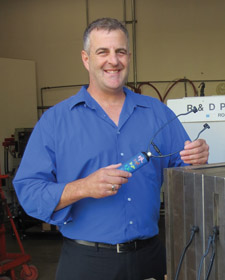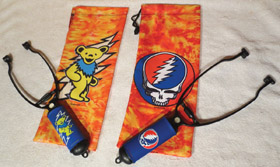“You achieve a sense of well-being that leads to relaxation, which leads to reducing stress.” —Joe Meisch
In 2000, after 13 years of service, including during the Gulf war as a member of the 579th Engineer Bn Combat Engineer 12B, Napa native Joe Meisch was given an honorable discharge due to a medical disability. Although he didn’t experience on-the-ground combat, he was still familiar with the problems that would plague many of his fellow returning vets, specifically post traumatic stress disorder (PTSD).
 After his discharge, Meisch began to develop symptoms that included heavy stress and muscular facial pain in his lower jaw. One night, driving home from a concert and bothered by the highway glare, he noticed that he was tense, irritable and had a headache. “I realized that my sunglasses were sitting on top of my head,” Meisch remembered, “so I pulled them down and began using the tips to massage my temples, using the bridge of the sunglasses to create a circular motion on my temples. The effect was immediate, and I noticed there was a calming sensation in my jawline and a warm feeling in the temple area; my head felt better and my focus returned.”
After his discharge, Meisch began to develop symptoms that included heavy stress and muscular facial pain in his lower jaw. One night, driving home from a concert and bothered by the highway glare, he noticed that he was tense, irritable and had a headache. “I realized that my sunglasses were sitting on top of my head,” Meisch remembered, “so I pulled them down and began using the tips to massage my temples, using the bridge of the sunglasses to create a circular motion on my temples. The effect was immediate, and I noticed there was a calming sensation in my jawline and a warm feeling in the temple area; my head felt better and my focus returned.”That experience caused him to recognize some benefits of a temple massage and created an interest in finding out if he had a possible product. He began to study plastic and, after many prototypes, he created his first mold. In 2004, he applied for a patent and, much to his pleasure, discovered no such product had been patented. Once he began work with Craig Stainbrook, a certified patent attorney, Meisch began to see his vision come into being.
The main thrust in his effort was to achieve two objectives: Create a drug-free device that, through musculature stimulation, could easily evoke the relaxation response in the brain to decrease stress; and ensure the device could treat conditions that include Bruxism (teeth grinding), TMJ (Temporomandibular [jaw and facial] disorders) and headaches.
Meich believes that what’s happening with the Temple Massager is similar to what happens when you get your hair shampooed at a barber shop or hair dressers’. “You achieve a sense of well being that leads to relaxation, which leads to reducing stress,” he explains.
An important component was to have a product that could be made in America, which Meisch accomplished by working with Tom Hansen at RD Products in Rohnert Park. “I kept looking for a manufacturer in the United States and was happy that RD Products was also a local business,” he says.
The final product is a simple tool, designed to help massage the temples and jaw muscles to give the user a direct and pleasurable, stress-reducing experience. For those who like aromatherapy, there’s a section in the massager where a user can add three to four drops of his or her favorite essential oils.
Knowing that the massager was a stress-reducing device and aware of the problems combat vets have with PTSD, Meisch has donated more than 1,300 Temple Massagers to service members all over the world, including sending some to Walter Reed Medical Center, Bethesda National Navy Medical Center and to combat engineers in Afghanistan. In 2009, the product was endorsed by Dr. Mark Abramson, DDS, of Stanford University School of Integrative Medicine’s mindfulness-based stress reduction center. Abramson says in his evaluation, “With a combination of my focus with both my clinic patients with TMJ and facial pain and with the stress education clinic at Stanford, I feel the Temple Massager has significant potential for being a useful tool with the armed services personnel who are under chronic stress in their performance duties.”
In a 2010 letter, Cory T. Marks, California Army National Guard CPT, EN, CA-ARNG, commanding, reported: “During both the mobilization training and deployment, the men of the 235th operated under a very stressful environment. Several men used the Temple Massager as a natural stress-relief mechanism to help deal with the day-to-day stressors faced.”
 In 2014, several great things happened for Meisch. Grateful Dead distributor Warner Music was so impressed that he was donating the Temple Massagers to service members and vets, it was inspired to support the project. He was given a license agreement that will let him use the signature images of “Steal Your Face” and “Dancing Bears.” Meisch is excited because this will help him with his marketing. “They make money, I make money—and this will let me continue donating the massagers to vets and service members, plus offer discounts.” For him to get the contract, he had to reassure Warner Music that he’d continue to provide the Temple Massager to vets.
In 2014, several great things happened for Meisch. Grateful Dead distributor Warner Music was so impressed that he was donating the Temple Massagers to service members and vets, it was inspired to support the project. He was given a license agreement that will let him use the signature images of “Steal Your Face” and “Dancing Bears.” Meisch is excited because this will help him with his marketing. “They make money, I make money—and this will let me continue donating the massagers to vets and service members, plus offer discounts.” For him to get the contract, he had to reassure Warner Music that he’d continue to provide the Temple Massager to vets.Although it’s been a long road, Meisch attributes his success to his philosophy. “I believe to always put the mission first, never give up and never accept defeat.” With that attitude, Meish is now working on his third mold, which he believes is even better than the first two. You can find his product at www.templemassager.com.



